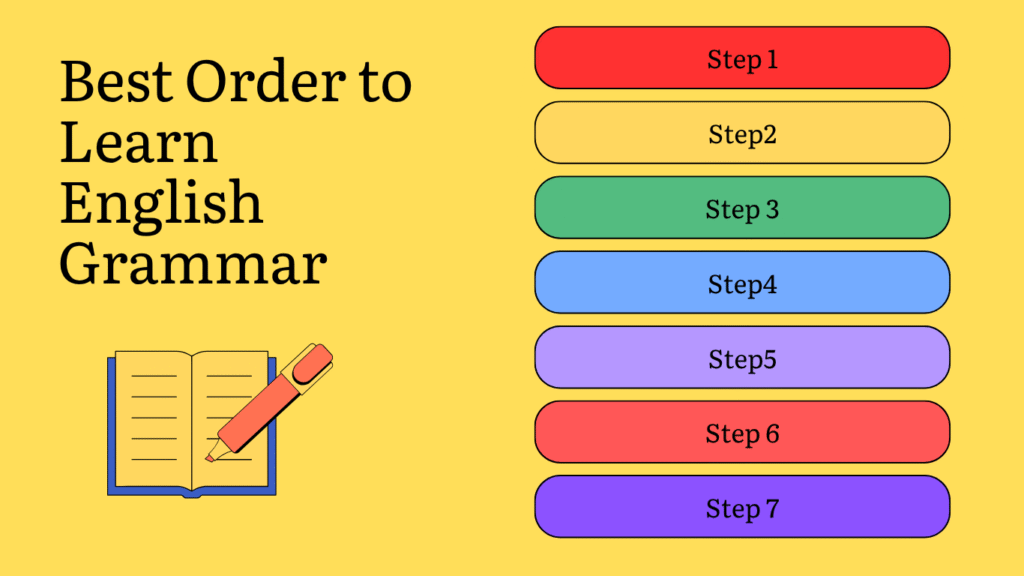If you’re a parent exploring Learning English as a second language online for kids, this guide shows you The Best Order to Learn English Grammar. With a clear step‑by‑step progression, your child will build confidence and fluency—and online programs like Novakid provide friendly, structured lessons designed just for young learners.

1. Start with Simple Sentence Structure
Introduce basic Subject–Verb–Object patterns: She eats apples.
These simple structures form the foundation for all communication.
Once children grasp this, they can naturally layer in more grammar as they learn.
2. Learn the Verb “To Be” + Personal Pronouns and Articles
Focus on am, is, are in simple statements, negatives, and questions.
Example patterns:
- I am a student.
- She is not tired.
- Are they friends?
Alongside, teach pronouns (I, you, he, she…) and articles (a, an, the)
- She is my teacher. | An apple on the table.
These are core parts of everyday conversation for young learners.
All of this aligns with the recommendations in the article “The Best Order to Learn English Grammar” on Novakid where they first emphasize simple structure and the verb “to be”
3. Practice Simple Tenses (Present, Past, Future)
Once basic structure and “to be” are understood, move on to simple tenses:
- Present Simple for routines: I go to school.
- Past Simple for past actions: I went yesterday.
- Future Simple with will: I will go tomorrow.
These tenses help children communicate clearly about time and daily life.
4. Study Plurals & Countable/Uncountable Nouns
Teach plural rules: regular (dog→dogs) and irregular (man→men).
Introduce quantifiers: some, many, a few, depending on countable vs. uncountable nouns.
Practice with familiar vocabulary like food, toys, and objects.
5. Add Prepositions and Word Order Rules
Introduce small but powerful words showing place/time: in, on, at, under.
Examples:
- The book is on the table.
- She is at school.
Reinforce correct sentence order in questions and statements.
6. Teach Continuous Tenses (Progressive Forms)
Present Continuous: I am eating.
Past Continuous: She was reading.
Future Continuous: They will be playing.
These express ongoing actions and add nuance to communication
7. Introduce More Advanced Topics
Once the basics are solid, slowly build toward:
- Passive voice
- Reported speech
- Conditionals (if‑clauses)
Although more complex, these become accessible after a strong foundation is in place.

Why This Order Works for Kids Online
Logical progression: Grammar flows naturally from foundations to complexity.
Useful for conversation: Early lessons center on structures kids use daily.
Supports online learning platforms: Novakid and other ESL platforms follow similar structured approaches to build confidence gradually.
How Parents Can Support the Process
Set daily exposure: Short, regular lessons are more effective than longer, rare sessions.
Add fun grammar practice: Use exercises, games, or interactive quizzes. Novakid offers top grammar exercises for kids to reinforce each concept
Incorporate reading and writing: Simple stories and journal entries help embed grammar in context—see Novakid’s article on reading & writing benefits
FAQs for Parents
It builds the essential framework for everything else—helps children form even simple sentences before introducing complexity.
Once kids use to be confidently and form simple sentences (usually a few weeks to months, depending on the child and exposure).
A little mixing is fine, but sequenced building helps avoid confusion and boosts confidence when each step is mastered.
Yes! Grammar games and context‑based learning (like stories) reinforce rules naturally while keeping it fun.
Use repetitive, spoken practice with familiar topics: I am happy, You are my friend, etc., until it feels comfortable.
Only after your child is regularly using simple and continuous tenses confidently—typically after 6‑12 months of regular learning.
Conclusion
By following this structure ensures your child builds a strong foundation step by step, reducing frustration and increasing fluency. Combined with structured online programs like Novakid, fun grammar exercises, and regular reading and writing, your child will be well on their way to confident English communication.
You can explore more about grammar order and teaching strategy by sigining up for a Free Trial class with Novakid. By signing up for an online English course, you can bring structured, engaging learning directly to your child’s home.


Leave a Reply